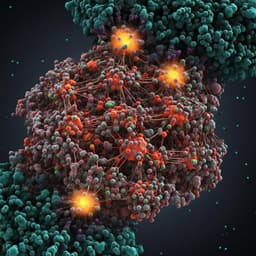
Space Sciences
Primordial aqueous alteration recorded in water-soluble organic molecules from the carbonaceous asteroid (162173) Ryugu
Y. Takano, H. Naraoka, et al.
Discover the intriguing primordial aqueous alteration signatures found in water-soluble organic molecules from the carbonaceous asteroid (162173) Ryugu. This research, conducted by a team of scientists including Yoshinori Takano and Hiroshi Naraoka, unveils the prevalence of low-molecular-weight hydroxy acids and dicarboxylic acids, shedding light on the coevolutionary relationship between water and organics in space.
~3 min • Beginner • English
Introduction
Pristine samples from the near-Earth carbonaceous asteroid (162173) Ryugu returned by Hayabusa2 provide a unique opportunity to investigate primordial organic astrochemistry preserved for over 4.6 billion years. Key questions include the role of carbonaceous asteroids in Solar System history, the origins and characteristics of light elements (C, N, H, O, S) and their isotopic compositions, how organic evolution is recorded on asteroids, the nature of molecular chirality, and how interactions between water, organic matter, and minerals affect chemical diversity. To address these, the Hayabusa2 soluble organic matter team analyzed aggregate fine grains from the first and second touchdown sites (TD1 surface A0106 and TD2 near the artificial crater C0107, possibly sampling subsurface material at ~1.7 m depth), aiming to characterize water-extractable hydrophilic organic molecules and assess signatures of parent-body aqueous alteration. The study builds on previous work documenting Ryugu’s isotopic profiles, organic diversity, and mineral associations, and focuses on hot-water extractable polar compounds and their implications for aqueous processing and prebiotic chemical evolution.
Literature Review
Prior analyses of Ryugu samples have revealed diverse soluble organic molecules (~20,000 species by FT-ICR/MS), isotopic compositions of C, N, H, O, S, amino acids and N-heterocycles, salts and sulfur-bearing labile molecules at organic–inorganic interfaces, hydrocarbons and PAHs, and spatial distributions of organics at sub-mm scales. Sequential extraction from initial bulk (IB) through insoluble organic matter (IOM) has shown molecular diversity and growth signatures. Comparisons to CI and CM carbonaceous chondrites (e.g., Orgueil, Ivuna, Murchison, Murray) provide context for aqueous alteration and thermal histories affecting amino acid and hydrophilic molecule abundances. Earlier studies reported α-hydroxy acids, dicarboxylic acids, and key metabolic precursors (pyruvic and citric acids) in meteorites, and laboratory work has linked urea, glycolic acid, and glycerol production to UV-processed ice analogs. Malonic acid tautomerization and decarboxylation mechanisms have been proposed in aqueous systems and implicated in meteoritic dicarboxylic acid formation. These frameworks motivate a targeted examination of Ryugu’s water-extractable hydrophiles to trace aqueous alteration and potential prebiotic relevance.
Methodology
Samples A0106 (TD1 surface) and C0107 (TD2 near artificial crater) were processed under contamination-controlled curation. For hydrophilic molecules, ~10 mg of each sample underwent hot water extraction in sealed ampoules at 105 °C for 20 hours to target water-extractable compounds (including hydroxy acids). Extracts and appropriate blanks (ultrapure water) were analyzed by capillary electrophoresis coupled to high-resolution mass spectrometry (CE-HRMS). The CE system (Agilent 7100) interfaced to a Q Exactive Plus orbitrap mass spectrometer used a fused silica capillary (50 μm i.d., 80 cm total length) and HMT electrolyte (H3301-1001). Data acquisition used Agilent MassHunter and Thermo Xcalibur; migration time alignment used HMT kits, and peak extraction/integration employed MasterHands. Identification leveraged migration time and exact monoisotopic mass with reference standards, including Murchison meteorite extracts and authentic standards, with mass accuracy within ~1 ppm. Sequential extraction workflow also included hot water extract (#7-1), formic acid extract (#9), and HCl extract (#10) for isotopic mass balance assessments. Elemental abundances of C, N, H, S and isotopic compositions (δ13C vs VPDB, δ15N vs Air, δD vs VSMOW, δ34S vs VCDT) were measured using ultra-sensitive nano-EA/IRMS (Flash EA1112/Conflo III/Delta Plus XP) at JAMSTEC for C, N, S, and EA/IRMS (Delta Plus XL) at Kyushu University for H. Insoluble organic matter (IOM) residues were analyzed in parallel. Additional analyses included SALDI-MS (AP-SMALDI-S coupled to Q Exactive; positive mode, 140,000 resolution, 20 μm laser, 60 Hz, 30 pulses/spot, ~130 spots over 300×300 μm) for IOM-related materials; FTIR transmission microscopy (Nicolet iN10, BaF2 substrate, MCT detector under dry N2 purge) and UV-Vis spectroscopy (NanoDrop One C, 190–1100 nm) of solvent extracts; and GC/MS (Agilent 7890B/5975C, VF-5MS column, 40→120 °C at 30 °C/min, then 120→320 °C at 6 °C/min, hold 20 min) of n-hexane extracts from IOM to identify cyclic sulfur species (S6, S7, S8) via authentic standards and NIST library matches. Data from CE-HRMS were used to quantify hydroxy acids, mono-, di-, and tricarboxylic acids, and N-bearing hydrophiles at ppb levels; element/isotope mass balances were assessed across IB, ΣSOM, and ΣIOM fractions.
Key Findings
- Hot-water extracts from both Ryugu samples (A0106, C0107) contained abundant low-molecular-weight hydroxy acids (e.g., glycolic, lactic, glyceric) and a broad suite of structural isomers (α- and β-hydroxy acids). Concentrations of individual hydroxy acids were determined on the ppb scale; hydrophilic molecule totals span ppb to ppm across compound classes.
- Biochemically relevant intermediates were identified, including pyruvic acid, mevalonic acid, and citric acid, linking to pathways such as lipid biosynthesis and the tricarboxylic acid (TCA/Krebs) cycle.
- Diverse carboxylic acids were detected: monocarboxylic acids (aliphatic, aromatic, unsaturated, keto) and dicarboxylic acids (oxalic C2, malonic C3, succinic C4, glutaric C5, adipic C6), as well as dicarboxylic hydroxy acids (e.g., malic, citramalic) and maleic acid. Nitrogen-bearing hydrophiles included urea, methylurea, higher alkyl-ureas (up to C6), amines, glycocyamine, and hydroxy/N-heterocyclic indoles.
- The relative abundance of lactic acid (C3) exceeded glycolic acid (C2), consistent with Murchison meteorite trends. Short-chain α-hydroxy acid quantification matched external standards and meteorite references (glycolic acid normalized comparisons).
- Evidence of aqueous alteration is recorded in the dicarboxylic acid profile: malonic acid shows behavior consistent with keto–enol tautomerism leading to decarboxylation to acetic acid and CO2. The relative abundance of malonic acid in Ryugu is an order of magnitude lower than in CM chondrites (Murchison, Murray), indicating a distinct aqueous history.
- Systematics between TD1 (A0106) and TD2 (C0107) show strong correspondence: hydroxy acids and other hydrophiles, amino acids/amines (CHNO series), and inorganic cations/anions plot near the 1:1 line, suggesting broadly similar surface and subsurface hydrophilic chemistry.
- ΣCNHOS in IB for A0106 and C0107 was on the order of the low-twenties wt%, and increased by about an order of magnitude in the IOM fraction due to removal of inorganic matrices, highlighting concentration of organics in IOM.
- Urea and alkyl-ureas were quantified (ppb levels for organics; ammonium also detected among inorganic ions), indicating primitive nitrogen carriers and potential reservoirs of involatile C, N, O, H on Ryugu.
- Stepwise extraction isotopic balances showed 15N-enrichment in soluble extracts (e.g., hot-water extracts up to +63.1‰ for A0106 and +55.2‰ for C0107 vs Air). Corresponding insoluble residues became relatively 15N-depleted (down to ~+28.2 ± 3.8‰) and 13C-depleted (to −17.0 ± 0.2‰). Sulfur isotopes converged near 0‰ (VCDT) before and after extraction.
- Comparative analyses with CI (Ivuna) and CM (Murchison, Murray) show that Ryugu’s hydrophilic molecule concentrations are generally lower and indicate a different aqueous alteration history. Principal component analysis separated Ryugu (CI-like) from CM samples.
- Thermal constraints suggest Ryugu samples remained below −100 °C after aqueous alteration based on structural water, consistent with cold hydrothermal alteration scenarios.
Discussion
The identification of abundant water-soluble hydroxy, mono-, di-, and tricarboxylic acids, including key biochemical intermediates, demonstrates that Ryugu’s regolith recorded extensive interactions between water and organic matter. The detection of malonic acid and its inferred keto–enol tautomerism/decarboxylation signature provides a mechanistic tracer of aqueous alteration not only indicating the occurrence of water-rock-organic processing but also differentiating Ryugu’s history from CM chondrites, which show higher relative malonate. Close agreement between TD1 and TD2 profiles suggests limited heterogeneity between surface and near-subsurface hydrophiles at the analyzed scale, supporting a broadly homogeneous distribution of soluble organics across these locales. Nitrogen systematics—15N-enriched soluble fractions paired with 13C- and 15N-depleted IOM residues—mirror meteoritic trends and constrain nitrogen dynamics and fractionation during parent-body processing. Comparisons to CI/CM meteorites and PCA positioning indicate Ryugu’s CI-like character with relatively lower amino acid and hydrophilic molecule abundances consistent with extensive aqueous alteration under cold conditions. Collectively, these observations support a coevolutionary model in which cold hydrothermal cycles and wet–dry processes in Ryugu’s parent body drove mineral alteration, salt formation, and diversification of hydrophilic organics, offering insight into prebiotic chemical evolution pathways preserved in primitive asteroids.
Conclusion
This study provides the first comprehensive inventory of hot water-extractable hydrophilic organic molecules from two Hayabusa2 Ryugu samples, revealing abundant low-mass hydroxy acids, diverse mono-/di-/tricarboxylic acids, and N-bearing species (urea, amines), including metabolic intermediates relevant to primordial chemical evolution. Dicarboxylic acid patterns, especially reduced malonic acid relative to CM meteorites and its tautomerism signature, furnish direct evidence of aqueous alteration and differentiate Ryugu’s alteration history. The strong correspondence between TD1 and TD2 highlights broadly similar hydrophilic chemistry across surface and near-subsurface materials. Isotopic mass balance trends of C and N between soluble and insoluble fractions align with meteoritic observations and constrain parent-body processing. These results reinforce the view that carbonaceous asteroids are natural laboratories for early Solar System organic evolution under cold hydrothermal conditions. Future work should expand compound-specific isotope analyses, enantiomeric assessments of chiral molecules, and comparative studies with Bennu samples to probe the origin of water, extent and timing of alteration, and the role of chirality in prebiotic chemistry.
Limitations
Enantiomeric (chirality) analyses of chiral hydroxy and carboxylic acids were not addressed. Quantification focused on hot water-extractable fractions and may not capture less soluble or mineral-bound organics. The study analyzed aggregate small-mass aliquots (~10 mg) from two locations, potentially limiting detection of fine-scale heterogeneity. Some abundance and mass-balance figures are constrained by detection limits and potential degradation pathways (e.g., tautomerism/decarboxylation of malonic acid) that can alter primary distributions. The origin of Ryugu’s water and detailed timing of alteration remain to be resolved in future investigations.
Related Publications
Explore these studies to deepen your understanding of the subject.







